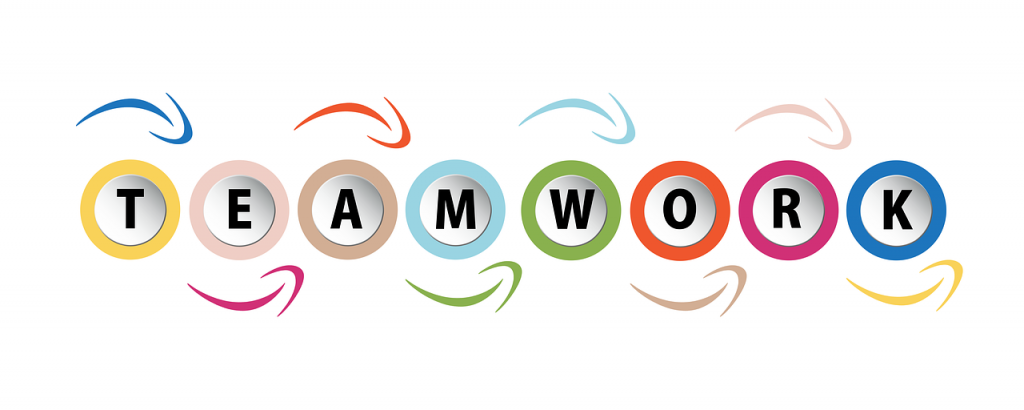7.4 Teamwork and Leadership
Two important aspects of group communication—especially in the business environment—are teamwork and leadership. You will work in a team and at some point may be called upon to lead. You may emerge in that role as the group recognizes your specific skill set in relation to the task, you may be appointed to a position of responsibility for yourself and others, or you may volunteer to lead a team. Your communication skills will be your foundation for success as a member and as a leader. Listen and seek to understand both the task and your group members as you become involved with the new effort. Have confidence in yourself and inspire the trust of others. Know that leading and following are both integral aspects of effective teamwork.

Teamwork
Teams are a form of group normally dedicated to production or problem solving. Like groups, teams can often achieve higher levels of performance than individuals because of the combined energies and talents of the members. Collaboration can increase motivation and creativity. Individuals have a sense of belonging to the group, and the range of views and diversity can energize the process, helping address creative blocks and stalemates. By involving members of the team in decision-making, and calling upon each member’s area of expertise, teamwork can result in better problem solving that leads to greater innovation, improved quality, and increased success.
Teamwork is not without its challenges. The work itself may prove a challenge as members juggle competing assignments and personal commitments. The work may also be compromised if team members are expected to conform and pressured to go along with a procedure, plan, or product that they themselves have not developed. Groupthink, or the tendency to accept the group’s ideas and actions in spite of individual concerns, can also compromise the process and reduce efficiency. Personalities and competition can play a role in a team’s failure to produce.
We can recognize that people want to belong to a successful team, and celebrating incremental gain can focus the attention on the project and its goals. Members will be more willing to express thoughts and opinions, and follow through with actions, when they perceive that they are an important part of the team. By failing to include all team members, valuable insights may be lost in the rush to judgment or production. It is crucial to make time for planning, and to allow each member time to study, reflect, and contribute; by so doing, team members can gain valuable insights from each other, and may be more likely to contribute information that challenges the status quo. Unconventional or “devil’s advocate” thinking may prove insightful and serve to challenge the process in a positive way, improving the production of the team. Respect for divergent views can encourage open discussion.
John Thill and Courtland Bovee (2002) provide a valuable list to consider when setting up a team as follows:
- Select team members wisely
- Select a responsible leader
- Promote cooperation
- Clarify goals
- Elicit commitment
- Clarify responsibilities
- Instill prompt action
- Apply technology
- Ensure technological compatibility
- Provide prompt feedback
Group dynamics involve the interactions and processes of a team and influence the degree to which members feel a part of the goal and mission. A team with a strong identity can prove to be a powerful force, but it requires time and commitment. A team that exerts too much control over individual members can run the risk of reducing creative interactions and encourage tunnel vision. A team that exerts too little control, with attention to process and areas of specific responsibility, may not be productive. Team members represent diverse viewpoints and approaches to the problem making it challenging to find the balance between motivation and encouragement, and control and influence. A skilled business communicator creates a positive team by first selecting members based on their areas of skill and expertise, but attention to their style of communication is also important. Individuals that typically work alone or tend to be introverted may need additional encouragement to participate. Extroverts may need to be encouraged to listen to others and not dominate the conversation.
Leadership
Leadership is one of the most studied aspects of group communication. Scholars in business, communication, psychology, and many other fields have written extensively about the qualities of leaders, theories of leadership, and how to build leadership skills. It’s important to point out that, although a group may have only one official leader, other group members play important leadership roles. Making this distinction also helps us differentiate between leaders and leadership (Hargie, 2011). The leader is a group role that may be associated with a high-status position and may be formally or informally recognized by group members. In other instances, leaders emerge from within the group, and have no official title, role, or formal authority. Leadership is a complex of beliefs, communication patterns, and behaviours that influence the functioning of a group and move a group toward the completion of its task. A person in the role of leader may provide no or poor leadership. Likewise, a person who is not recognized as a “leader” by title or formal position, can provide excellent leadership.
Quick Quiz
Navigate to the following quick quiz: What’s Your Leadership Style?
Leadership Styles
Given the large amount of research done on leadership, it is not surprising that there are several different ways to define or categorize leadership styles. In general, effective leaders do not fit solely into one style in any of the following classifications. Instead, they are able to adapt their leadership style to fit the relational and situational context (Wood, 1977).

Read and review the following article from MindTools that describes a variety of leadership style models: Leadership styles: Choosing the right approach for the situation.
One common way to study leadership style is to make a distinction among autocratic, democratic, and laissez-faire leaders (Lewin, Lippitt, & White, 1939). These leadership styles can be described as follows:
- Autocratic leaders set policies and make decisions primarily on their own, taking advantage of the power present in their title or status to set the agenda for the group.
- Democratic leaders facilitate group discussion and like to take input from all members before making a decision.
- Laissez-faire leaders take a “hands-off” approach, preferring to give group members freedom to reach and implement their own decisions.
More recently, Copeland (2016) found values-based leadership styles to be most effective, namely authentic, ethical, and transformational leadership styles (p. 79). These three styles of leadership all involve some level of risk pertaining to vulnerability.
Vulnerability
Vulnerability research was popularized by Dr. Brené Brown through her years of research on shame. Utilizing vulnerability on a day-to-day basis can “demonstrate transparency and an openness to emotional exposure” (Lopez, 2018, ix). This section considers vulnerability and it’s relationship to trust, courage, and self-awareness (all three important to leadership), as well as three more contemporary leadership styles: authentic, ethical, and transformational.
Vulnerability is “the emotion we experience during times of uncertainty, risk, and emotional exposure” (Brown, 2018, p. 19); strong leaders expose themselves emotionally as they negotiate risk and uncertainty in our current global environment and its ever-increasing rate of change. “When a leader embraces failure and shares vulnerability with humility, followers are able to connect with the leader at an emotional level and are more likely to share feelings of vulnerability themselves” (Ito & Bligh, 2017, p. 67).
Some examples of actions that a vulnerable leader might take include reaching out to an employee with an ill child or family member, checking in with a coworker who experienced a recent loss, or taking responsibility for a mistake at work (Seppälä, 2014). “Collaboration, then, as a way to be morally accountable, requires a deep understanding of vulnerability: the generosity, humility, and patience needed to work through conflicts, misunderstandings, and miscommunications” (Pignatelli, 2011, p. 223).
Vulnerability directly involves the issue of trust (Brown, 2012a). Leaders “must be truthful and consistent in their behavior and must not arbitrarily disregard employees’ suggestions and opinions on a regular basis” (Thrash, 2012, p. 4). The best place to work “is one where employees trust the people they work with, have pride in the work they do, and enjoy the people they work with” (Bush & Lewis-Kulin, 2018). Kezar, Carducci, & Contreras-McGavin (2006) explain that “successful leaders are authentic and behave with consistency, can read the emotions of others, and attend to the emotional aspects of the organization” (as cited in Seefeld, 2016, p. 36).
Sané Bell wrote: “when I lack self-awareness as a leader and when I’m not connected with the intentions driving my thoughts, feelings, and actions, I limit the perspective and insights that I can share with the people I lead” (Brown, 2018, p. 179). “When leaders engage in reflective practices, their own goals and performance are likely to thrive” (Seefeld, 2016, p. 54). Sedikides, Slabu, Lenton, & Thomaes define authenticity as the “sense or feeling that one is in alignment with one’s true or genuine self” (as cited in Oc et al., 2020, p. 1).
“How much we know ourselves is extremely important, but how we treat ourselves is the most important” (Brown, 2012). As we grow up, “we experience pain, and shame, and struggle with worthiness, we shut down parts of ourselves. And we shut down those things that make us vulnerable” (Brown, 2012). “If I have never expected my closest family members to emotionally support or connect with me, then I am unfamiliar with the experience of being emotionally vulnerable; being encouraged to do so would likely feel prohibitive and foreign” (Chenfeng et al., 2016, p. 562). “When individuals feel less vulnerable or more secure in their relationships with others, they are more likely to let others see them for who they really are” (Oc et al., 2020, p. 4).
Wallace and Tice (2012) note that an individual’s desire to be socially accepted can affect whether they act authentically (Oc et al., 2020). Individuals often show an inauthentic version of themselves at work and may opt to do so because they feel vulnerable (as cited in Oc et al., 2020, p. 3). “At the same time, our capacity and need to take an action and demonstrate initiative speaks, equally, to our vulnerability and fragility, to the very real risk of inflicting both intended and unintended pain” (Pignatelli, 2011, p. 225).
Vulnerability and Gender/Identity
Fletcher (2004) reflects that traditional leadership characteristics tend to be masculine “such as individualism, control, assertiveness, and skills of advocacy and domination” while more modern characteristics are considered feminine “such as empathy, community, vulnerability, and skills of inquiry and collaboration” (p. 650). While people may instinctively think of the masculine traits when describing a leader, an effective leader needs to have an “androgynous combination of feminine and masculine traits” (Hoyt, 2010, p. 486).
When discussing the myth of vulnerability as a weakness and that people don’t “do vulnerability,” Brown (2012a) notes that statement is “normally followed up by a gender comment or a professional comment” such as “I don’t do vulnerability, I’m a dude”. “Encouraging leader humility in the workplace may not be an easy task given that many organizational leaders fear that expressing humility demonstrates a lack of competence to others” (Oc et al., 2020, p. 21).
“Despite being underrepresented, women are perceived to have more desirable leadership qualities than men” (Seefeld, 2016, p. 41). Schreiber (2002) notes that “women continue to have perceptions about their position(s) in higher education, embracing a collaborative leadership style that can be misunderstood or disrespected, and at times, feeling out of sync with some male-dominated administrations” (as cited in Seefeld, 2016, p. 100).
Even more underrepresented are individuals who identify as non-binary (male or female). It is helpful that there is information that addresses an “androgynous combination of feminine and masculine traits” (Hoyt, 2010, p. 486), however, it is important to remember that these findings are not inclusive of all organizational members, and that leaders need to update their own knowledge base as new research becomes available.
Video: “The power of vulnerability” by Brené Brown [20:49](Transcript Available).
Ethical Leadership
 Brown et al. (2005) define ethical leadership as “the demonstration of normatively appropriate conduct through personal actions and interpersonal relationships, and the promotion of such conduct to followers through two-way communication, reinforcement, and decision-making” (p. 120). Kaptein (2019) adds that an ethical leader is not just a moral person and manager but also a “moral entrepreneur who creates new norms” (p. 1136). This entrepreneurship should lead to the “development of both society and the trust of stakeholders” (Kaptein, 2019, p. 1136). Brown and Treviño (2014) find that “leaders who have had ethical role models are more likely to become ethical leaders” (Kaptein, 2019, p. 1135).
Brown et al. (2005) define ethical leadership as “the demonstration of normatively appropriate conduct through personal actions and interpersonal relationships, and the promotion of such conduct to followers through two-way communication, reinforcement, and decision-making” (p. 120). Kaptein (2019) adds that an ethical leader is not just a moral person and manager but also a “moral entrepreneur who creates new norms” (p. 1136). This entrepreneurship should lead to the “development of both society and the trust of stakeholders” (Kaptein, 2019, p. 1136). Brown and Treviño (2014) find that “leaders who have had ethical role models are more likely to become ethical leaders” (Kaptein, 2019, p. 1135).
A leader needs to be “perceived as attractive, credible, and legitimate” in order to be an effective and influential ethical leader (Brown et al., 2005, p. 120). Kalshoven et al. (2011) also find that ethical leaders tend to be agreeable and conscientious (Kaptein, 2019). Brown et al. (2005) studied how MBA students described a leader they perceived as ethical. The results included a leader who listens, keeps their followers’ best interests in mind, is a role model when it comes to ethics, applies discipline when ethics are violated, makes fair decisions, and can be trusted (Kaptein, 2019).
Kaptein (2019) argues that ethical leadership is even an important part of transformational and authentic leadership “because ethics lies at the heart of leadership” (p. 1136).
Transformational Leadership
 Bass and Riggio (2006) describe transformational leadership as “motivating others through a common mission or challenge that empowers followers and encourages them to develop as leaders” (p. 3). Transformational leaders tend to have more satisfied, committed followers with elevated work performances (Bass & Riggio, 2006). This style of leadership addresses “the follower’s sense of self-worth” (Bass & Riggio, 2006, p. 4). Carleton, Barling, and Trivisonno (2018) also found a strong connection between a leader’s trait mindfulness and their positive actions as a transformational leader.
Bass and Riggio (2006) describe transformational leadership as “motivating others through a common mission or challenge that empowers followers and encourages them to develop as leaders” (p. 3). Transformational leaders tend to have more satisfied, committed followers with elevated work performances (Bass & Riggio, 2006). This style of leadership addresses “the follower’s sense of self-worth” (Bass & Riggio, 2006, p. 4). Carleton, Barling, and Trivisonno (2018) also found a strong connection between a leader’s trait mindfulness and their positive actions as a transformational leader.
The components of transformational leadership include idealized influence (acting as a strong role model), inspirational motivation (motivating others through a shared vision or common goal), intellectual stimulation (encouraging followers to find creative and innovative solutions), and individualized consideration (paying attention to each follower’s needs and adjusting mentoring strategies to fit those needs) (Bass & Riggio, 2006). Individualized consideration is most important when it comes to vulnerability as it “involves leaders creating relationships with followers that demonstrate care and attention with follower’s needs and emotions” (Simonis, 2015, p. 7). A leader who applies individualized consideration tends to build relationships with a greater level of trust (Simonis, 2015).
A concern regarding transformational leadership is that a leader could lead their followers astray with “destructive” and “selfish” motivations, making a leader’s authenticity vital in a successful relationship (Bass & Riggio, 2006, p. 4).
Authentic Leadership
 Authentic leadership has been described as “the process whereby leaders are aware of their thoughts and behaviors within the context in which they operate” (Maximo et al., 2019, p. 2). Walumbwa et al. (2008) outline the components of authentic leadership as self-awareness (a leader’s understanding of themselves including strengths and weaknesses), balanced processing (a leader’s ability to make objective decisions after weighing all the evidence), and relational transparency (a leader’s strength in communicating honest and genuine information as well as opinions) (Maximo et al., 2019, p. 2).
Authentic leadership has been described as “the process whereby leaders are aware of their thoughts and behaviors within the context in which they operate” (Maximo et al., 2019, p. 2). Walumbwa et al. (2008) outline the components of authentic leadership as self-awareness (a leader’s understanding of themselves including strengths and weaknesses), balanced processing (a leader’s ability to make objective decisions after weighing all the evidence), and relational transparency (a leader’s strength in communicating honest and genuine information as well as opinions) (Maximo et al., 2019, p. 2).
Michie and Gooty (2005) noted that emotions directed toward others motivate authentic leaders “to behave in ways that reflect self-transcendent values” (Avolio & Gardner, 2005, p. 318). For example, gratitude and appreciation (other-directed emotions) would be motivators for an authentic leader to model values of honesty and loyalty (Avolio & Gardner, 2005, p. 318).
Authentic leaders have a significant impact on their organization and their followers (Maximo et al., 2019); thus, authentic leadership should also focus on the relationship between the leader and the follower (Avolio & Gardner, 2005). Authentic followers are likely to display the same behaviors and traits described above, paralleling those exhibited by their authentic leader (Avolio & Gardner, 2005). Followers may also show “increased levels of trust and a stronger willingness to cooperate” (Maximo et al., 2019, p. 3).
As with any relationship based on trust, both parties take a risk in being vulnerable (Maximo et al,. 2019). Detert and Burris (2007) find that employees or followers may not take the risk “if they perceive these risks to result in negative consequences” or if they cause embarrassment (Maximo, et al., 2019, p. 3).
“76. Teamwork and Leadership” from Communication for Business Professionals by eCampusOntario is licensed under a Creative Commons Attribution-NonCommercial-ShareAlike 4.0 International License.
“4.4 Vulnerability in Leadership” from Principles of Leadership & Management by Laura Radtke is licensed under a Creative Commons Attribution-NonCommercial-ShareAlike 4.0 International License.

